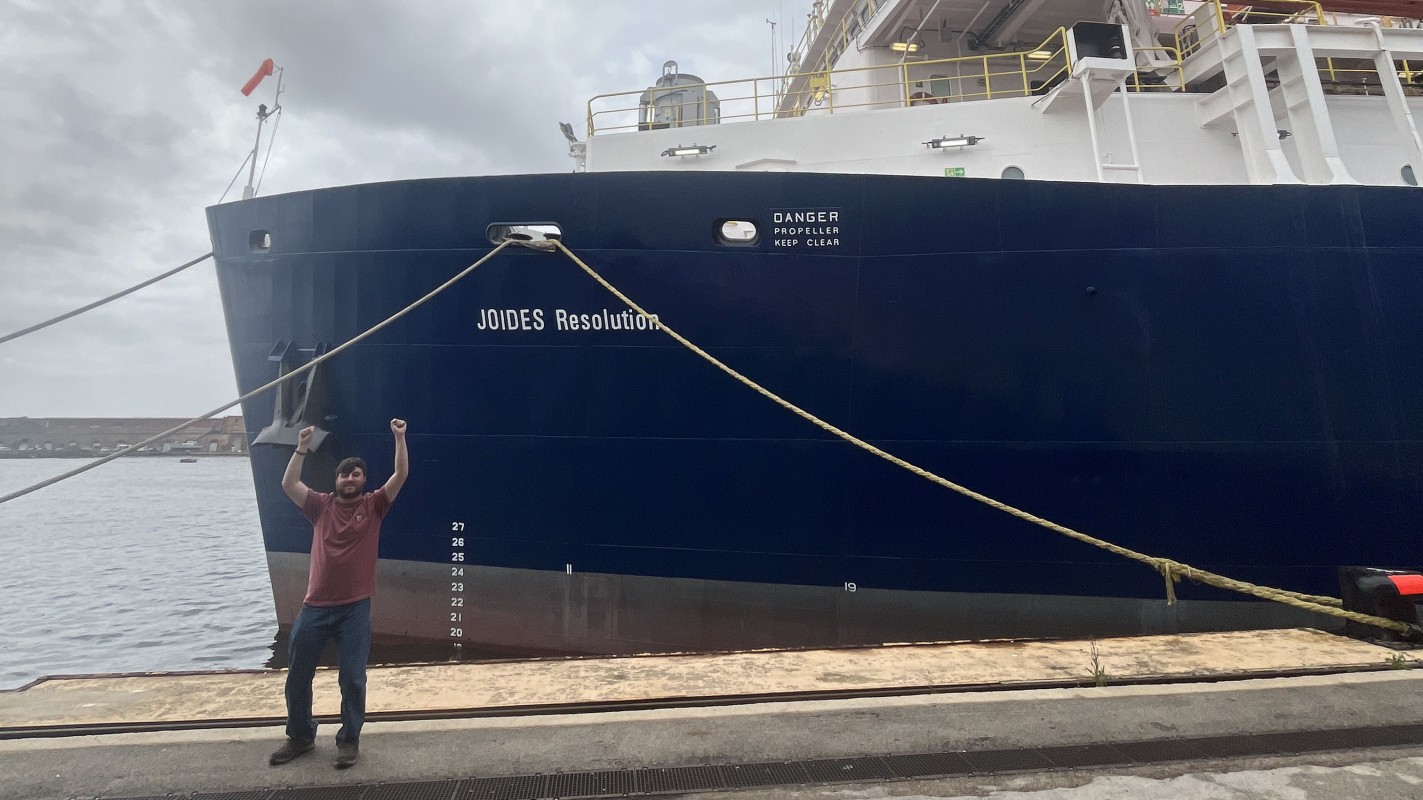Out to sea: Undergrad experiences ocean sciences firsthand
Michael Kashinsky spent two weeks on board the JOIDES Resolution, a deep-sea research vessel

During their journey, the crew of future scientists gathered on the deck of JOIDES Resolution, surrounded by the open sea. As they gazed upon the scarlet sunset, dolphins leaped from the water.
It’s an image that will stay with Binghamton University student Michael Kashinsky for a long time.
“It was almost a movie ending and just such a beautiful moment,” said the junior geological sciences major. “It just encapsulates what I felt as a whole: this beautiful, wonderful sense of community we made.”
The JOIDES Resolution — the acronym stands for Joint Oceanographic Institutions for Deep Earth Sampling — plays an almost legendary role in ocean science. Commissioned in 1985, the specialized ship can drill 2 kilometers into seafloor sediments, offering a glimpse into seas and climates of millennia past.
Kashinsky took part in JR Academy, a two-week at-sea experience where the students are given training in sailing, conducting science at sea and science communication, with a focus on Indigenous knowledge and partnerships. In a bittersweet twist, it may be among the ship’s final journeys; the ship will go on its last expedition this summer and there are no immediate plans to replace it.
The Long-Islander learned about the Resolution in Assistant Professor of Earth Sciences Adriane Lam’s lab; Lam, a paleontologist and paleoceanographer, has sailed on it herself.
Out of 100 applications, only 16 were accepted from around the globe; 14 of them were female, and many were Indigenous American, Maori or Australian Aborigine. Kashinsky was the only New Yorker among the contingent; the other Americans came from the Midwest, Texas, California, Washington State and the Navajo Nation, he said.
“It was really awesome to have that experience where I can learn about so many different people from so many walks of life, and we can discuss issues happening in the geosciences,” he said. “There are people I’m going to keep in contact with.”
As Kashinsky was climbing aboard the Resolution, Binghamton doctoral student Ravi Kiran Koorapati was disembarking from his own research expedition with the International Ocean Discovery Program — and, in essence, passing the torch.
“The JR Academy is one piece of the U.S. scientific ocean drilling initiative that is critical to training the next generation of scientists and a scientifically literate community with an eye towards diversity, inclusion, equity, and accessibility,” Lam said. “For any early-career scientist to sail on the JR is a life-changing experience, and we are so honored that our undergraduates, graduates and professors are so deeply involved and invested in the program.”
Diversity in and at sea
The ship sailed the Mediterranean Sea from Naples through the Strait of Gibraltar, then up the Atlantic coast of Spain and Portugal, through the Bay of Biscay and the English Channel, ending in Amsterdam.
Unlike oil drilling, ocean drilling for scientific research isn’t environmentally destructive; the hole left by a core extraction fills up with new sediment quickly, Kashinsky said. Participants learned how scientists analyze sediment cores and had the opportunity to do so themselves. Scientists navigate cores carefully, using toothpicks, sifting for microfossils or using technology for geochemical analysis.
One fascinating concept that Kashinsky explored was paleomagnetism. The Earth’s poles switch from north to south over time; magnetic minerals preserve that polarity in their structure when they form, giving scientists a way to date the core strata. Microfossils can also be used to date sediment cores, a phenomenon he studies in Lam’s lab.
“There are all these different factors in geoscience coming together when you look at this column of dirt taken from the bottom of the ocean,” he said.
Just as a diversity of life makes for a healthy ocean, participants explored the human side of diversity when it comes to the geosciences, including Indigenous populations. There is also a long history of geoscience being used in an extractive and even exploitative manner, such as the interaction between the mining industry and Indigenous communities, Kashinsky learned.
“As geologists, we work with the land, so it’s important to consult with the owners of that land,” he said.
He also explored the importance of the ocean to Indigenous cultures around the globe. New Zealand’s Maori people used subtle differences in coloration to distinguish the Pacific from the Southern Ocean, and the red light emitted from volcanic ash to locate remote islands, he said.
Living aboard a 190-foot ship is a recipe for deep conversations and lasting friendships.
Kashinsky is Jewish, and the trip marked the first time he spent Passover away from his family and the Jewish community. He brought matzah to share with his shipmates and had a chance to try vegemite, much-loved by the Australians; vegemite, it turns out, isn’t for everyone.
“It was one of the best times in my life so far,” he said.
The experience deepened his interest in oceanographic science. He hopes to incorporate marine science and science communication into his research when he becomes a professor, he said.
“Living on a boat for 14 days, I said to myself, ‘Yeah, I could see myself on this kind of ship doing science and going on a crazy adventure,’” he said.
